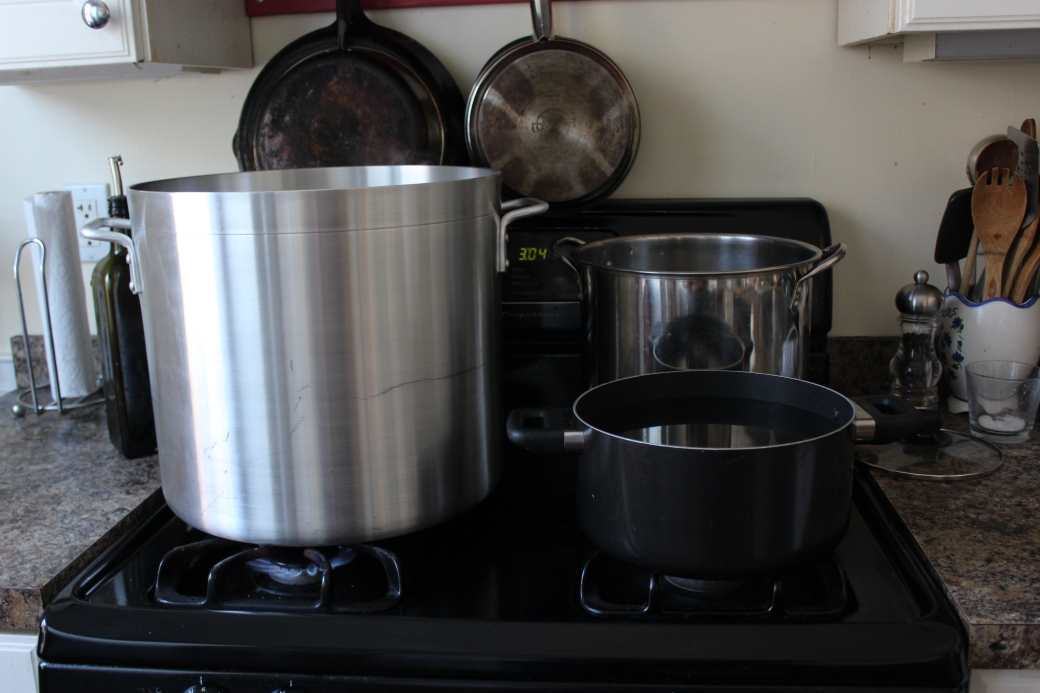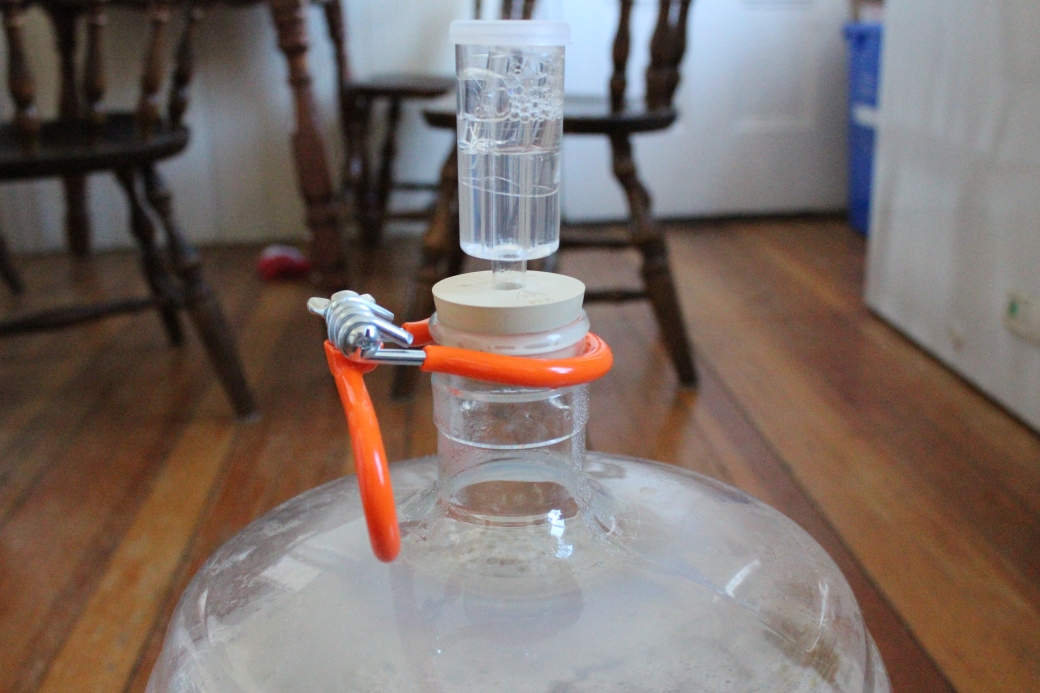I got my big pot. It holds eight gallons, which is huge for a pot. And it’s perfect for brewing five gallons of all-grain beer. I inaugurated it with the grain I bought too many weeks ago at the brew supply shop to make an IPA recipe from my John Palmer book. Milled grain is supposed to be good for about two weeks. I’d had this for… longer. But this was a learning experience, so I let it slide.

How big is this new pot, you ask? Big enough that I fit inside the box it came in. You can use this picture as a fun reference for size and for the low quality of the pictures I was taking with my phone.

The pot itself comfortably takes up two burners on the stove. Every pot in the house pitched in for this mission. In the big pot I heated about 5 1/2 gallons for the mash, which is the first mixture of water and grain. Between the two little guys on the right I heated 3 1/2 gallons for the sparge, which is the water flushed through the grain a second time to pick up any sugars the first bunch missed.

It takes a huge amount of grain to brew 5 gallons of beer. The recipe called for 10 pounds of pale ale malt and half a pound each of crystal malt and Munich malt. I managed to find all of these at the brew shop. In fact I chose this recipe because I could find them all.

I heated the big pot of water to 165F. It was at this point that I started to realize the shortcomings of my equipment. My book recommends using a big cooler as a mash tun. I don’t have a big cooler. (Strictly speaking, I do, but we use it for camping and it’s seen too many opened packs of days-old hot dogs for my taste).
The purpose of a mash tun is to hold the mash at a temperature of 152F for one hour. I have a gas stove, so keeping a pot at a more or less constant temperature isn’t a problem. But the book specifies that you should add your water to your grain, and not the other way around. Well, I’d just heated my water in the only stove-worthy container big enough to hold it. So I added the grain to the water, and not the other way around. I just hope I didn’t “thermally shock the enzymes,” as the book warns.

Checking the temperature frequently and strategically turning the burners on and off, I managed to keep the mash at a more or less constant 152F for an hour. After that, it was time to coerce Ben into helping me. Once I had a full batch of all-grain beer in front of me, my worst suspicions were confirmed: There is no way in hell I can move this much weight around on my own. I either have to get to the gym or always brew when someone else is home.
The point of this transfer was to separate the grain from the liquid, which at this point is called wort. I lined my 7.8 gallon bucket with a nylon sack held in place with clothespins. This was an idea hacked together on the spot, and I had no idea if the sack would rip apart or if the clothespins would go flying. Even though I couldn’t lift the pot, I lent a supporting foot.

Surprisingly enough, the sack and clothespin method worked well. Unfortunately at this point I discovered another big thing I was missing. In home brewing a mash tun usually doubles as a lauter tun, meaning it has a screened false bottom and a spigot. Open up the spigot, and the wort drains out slowly through the grain. My nylon sack served more or less as the false bottom, but what about the spigot? I had no way to drain the wort slowly.

What I wound up doing was simply lifting the sack out of the bucket. (Thank God it held). This gave me something like 3 gallons of wort. I think this was more or less fine, but it was the next step that did me in. I’d heated an additional 3.5 gallons of sparge water to 165F, because that’s what the book said to do. What you’re supposed to do next is close your spigot, let your grain sit in the sparge water for fifteen minutes, then open your spigot and let the wort drain out. It’s supposed to take as long as an hour. I didn’t have a spigot, though, so I couldn’t let the wort drain out slowly. Instead I let the grain sit in the sparge water for fifteen minutes, and then I lifted the bag of grain straight out. I effectively eliminated an hour’s worth of sugar extraction. Whoops.

I didn’t realize this, of course, until after I’d combined my first runnings wort with the sparge wort and took a gravity reading with my hydrometer. According to the book, I was to take my gravity points (22), and multiply them by the number of gallons of wort I’d produced (7 – since I’d effectively steeped my grain like tea rather than drip it like coffee, I’d wound up with more than my target 6 gallons). Then I was supposed to divide that number by the pounds of grain I’d used (11).
All this was to determine how much sugar I’d extracted from my grain. According to the book, a good target number was 28, though higher would be better. I got 14. After some initial panic, I remembered that hydrometers are calibrated for 59F. My wort was at about 140F, meaning my reading was something like 12 points lower than it should have been. So if my gravity was actually 34 points, that meant my extraction number was more like 22. Still lower than 28, but not disastrously low.
I still had my big bag of grain, and I probably could have somehow steeped it in the wort for longer. Space was at a real premium, though – I had nothing big enough to hold my seven gallons of wort together with my sack o’ grain. What I did have was some leftover dry malt extract from my last batch. I stirred it gradually into the wort until the hydrometer reached a level that gave me an extraction number of 28. I think I accidentally brewed a partial mash batch.

The despair of my low gravity behind me, I set the wort to boil on the stove. I boiled it for an hour, adding Nugget and East Kent Golding hops along the way. Once the hour was up, I cooled it in an ice bath in the sink. The beauty of brewing in the winter is that you have an endless ice bath supply right outside. Of course, I chose to do this on the coldest night of the year and had to brave temperatures approaching ten below every time I refilled my little snow bowl.

The wort chilled, it was time to find someone big to aerate it. I stole my friend Phil away from whatever he was doing and convinced him nothing would bring him more joy than sloshing a bunch of liquid back and forth between a kettle and a bucket.
I think he bought it.
Once the wort was good and bubbly, we moved it to the carboy. It wasn’t until after the fact that a discovered a piece of an airlock wedged in the the base of the funnel. I swear this happens every time. They must get stuck together soaking in the sanitizer. Someday I’ll use a clear funnel and I’ll be shocked at how easy it is.

I added my rehydrated yeast, stuck the airlock in place, and left it in the middle of the kitchen overnight. By the next morning it was bubbling nicely.

I asked Ben to move it into our closet, where it will be living until it’s time to bottle. He used the hot new carboy handle I ordered and had a much easier time of it than usual. Now all that’s left is to sit back and wait for the yeasts to do their thing.

And maybe get myself a lauter tun.



I love the adventure of home brewing hope it turns out nicely, salud!
LikeLike
Thanks so much! I really hope it turns out, too!
LikeLike
PS
Thanks for following me, we are launching a new blog in a few weeks so check us out at http://Carrascotradingpost.4leading.com .
LikeLike
Nice effort shots! Also, great to see other small space/stove top AG brewers! Hope the IPA turns out well. Cheers!
LikeLike
Thanks! I love brewing on the stove top – it’s convenient and it keeps the house warm. I’ll give an update when it’s ready, good or bad!
LikeLiked by 1 person
Pingback: Steeped Grains | Liz Baessler